An investigation into the factors that hinder the participation of the second-year English-major students in English speaking lessons at Thuong Mai University
This research is implemented to investigate the factors that hinder students’ participation in
speaking activities at Thuong Mai University. The research’s objects are the teachers and the
second-year English-major students of English from Thuong Mai University. To attain the aim
of the research, the questionnaires and interview were used as instruments to take data from 10
lecturers and 175 students. The revealed factors included affective-related problems, socially
related problems, instructor- related problems, educational system and facility-related problem
and linguistic-related problems. Of which, linguistic-related problems have the most effective
factor on students’ participation in speaking activities while instructor–related problems have the
smallest impact on students’ participation in speaking activities. In addition, some suggestions are
made with the hope for better methods to help the teachers reduce their students’ negative effect
of these factors during the process of learning speaking English.
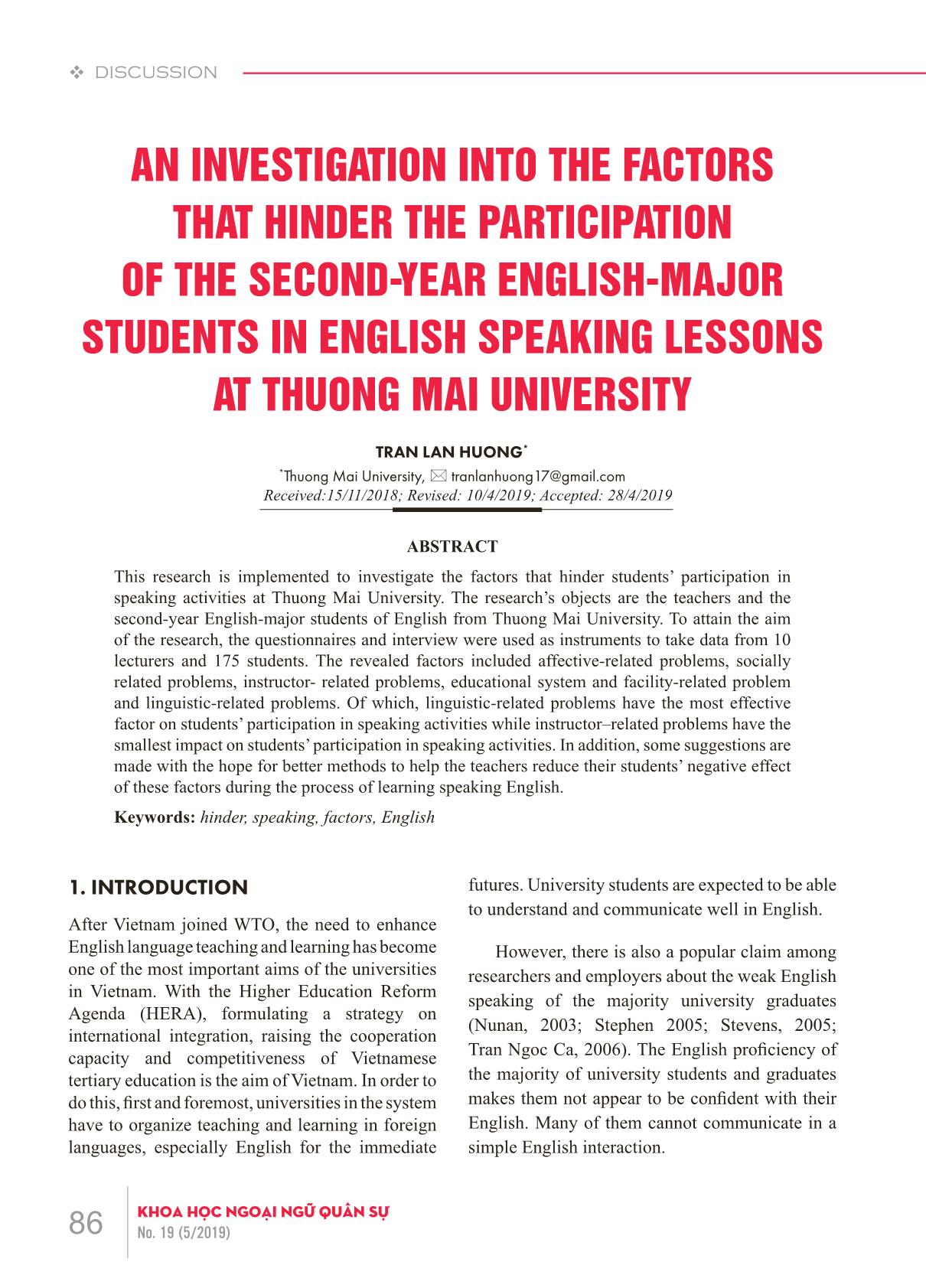
Trang 1
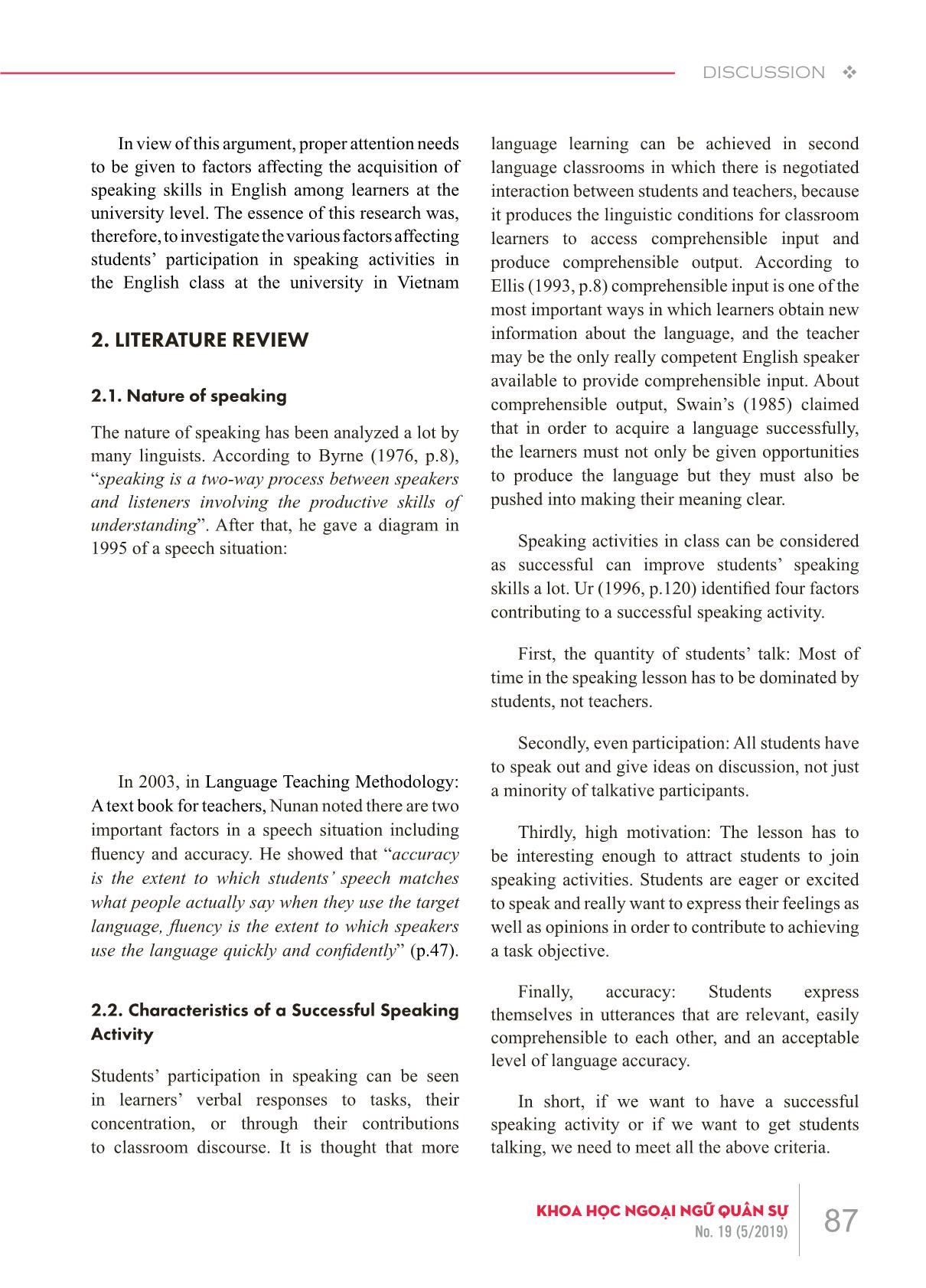
Trang 2
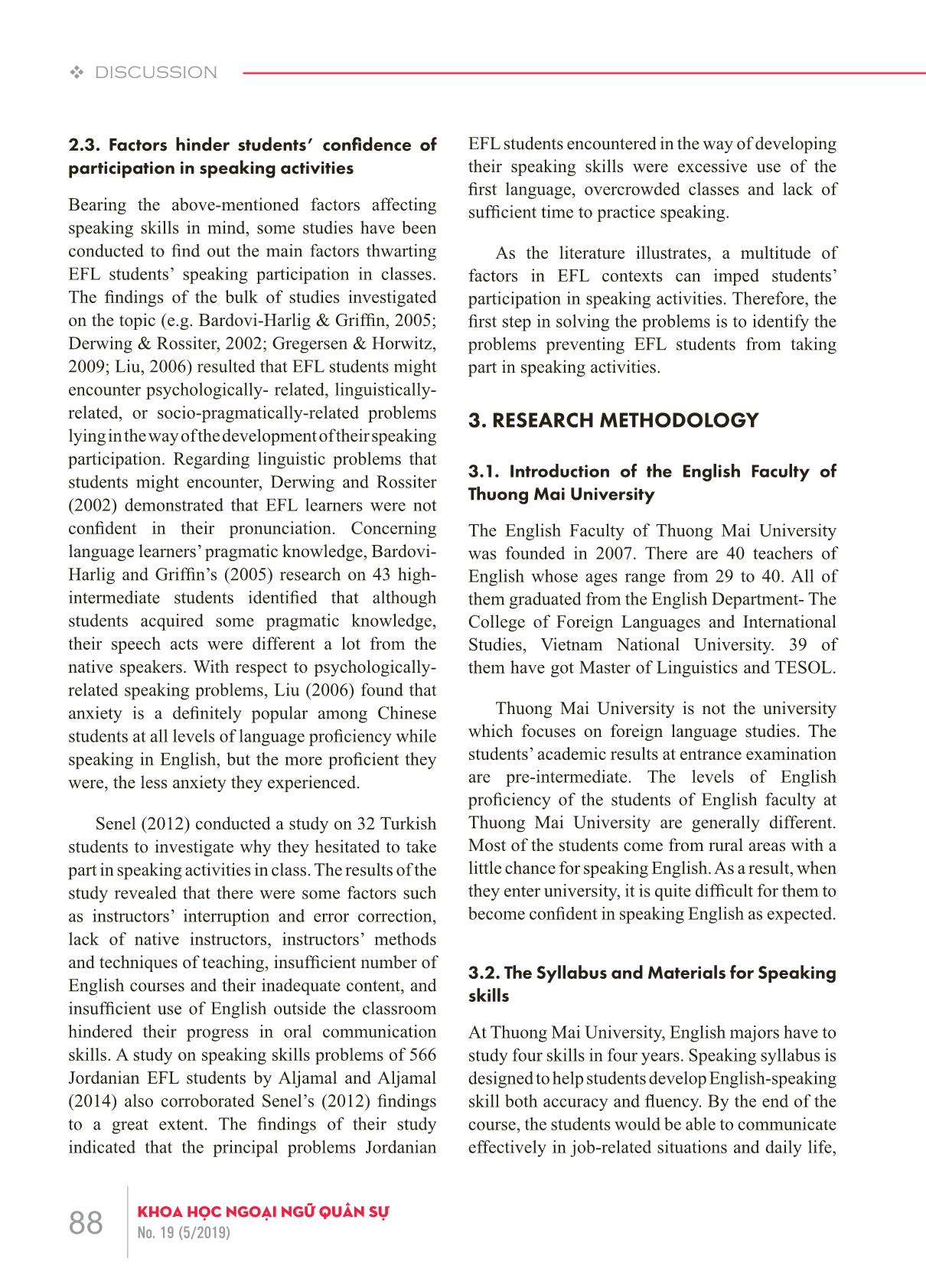
Trang 3
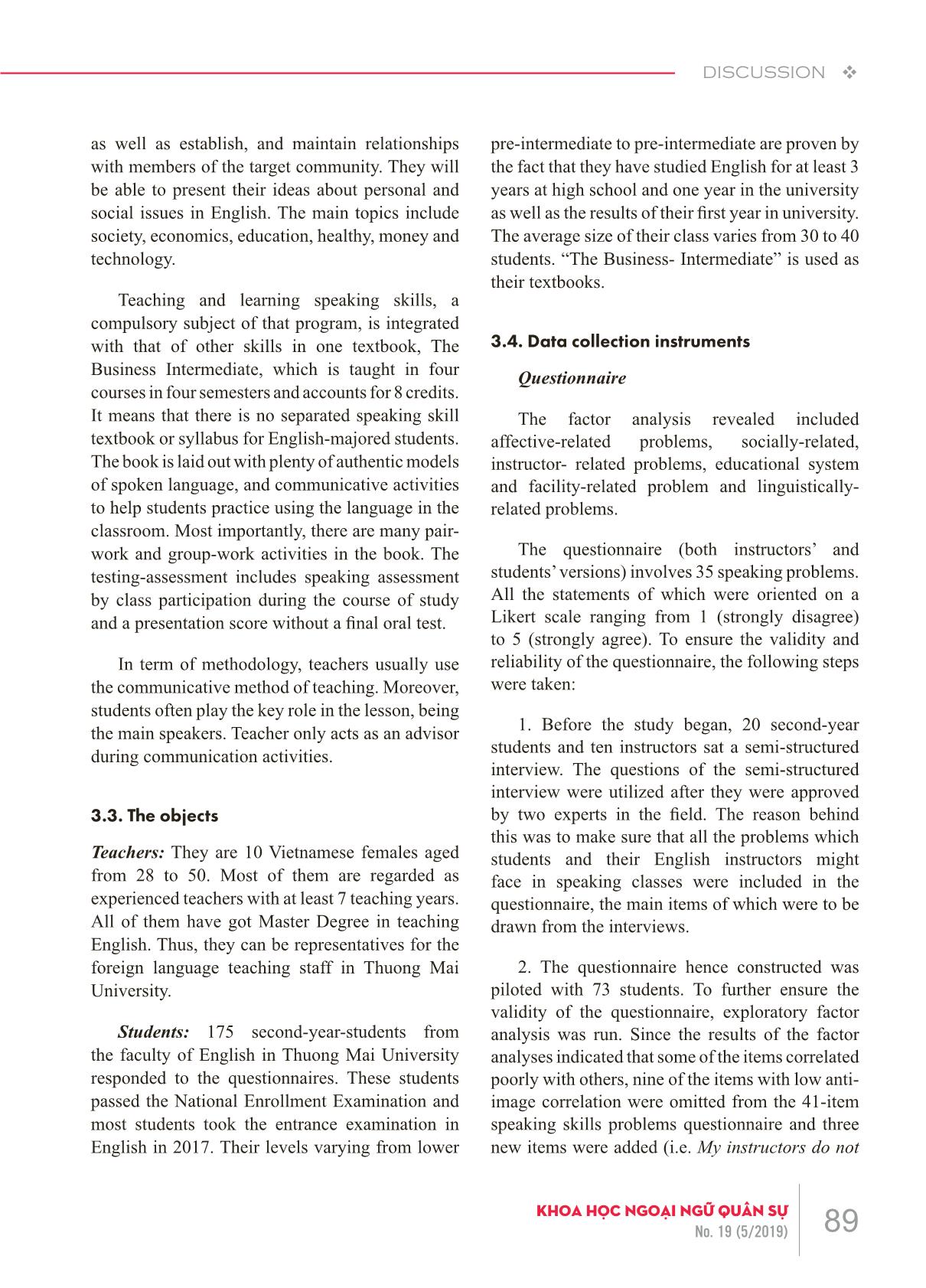
Trang 4
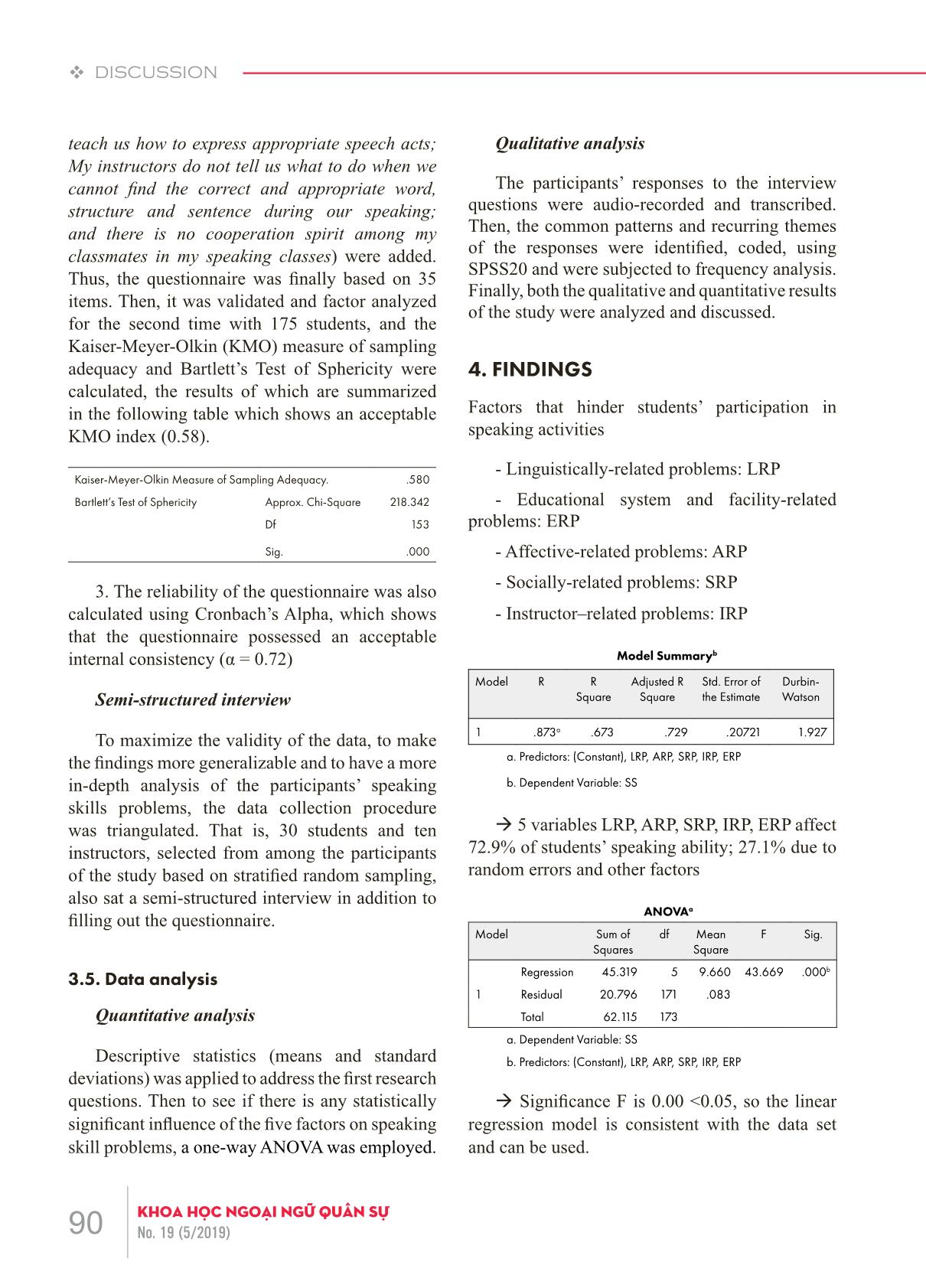
Trang 5
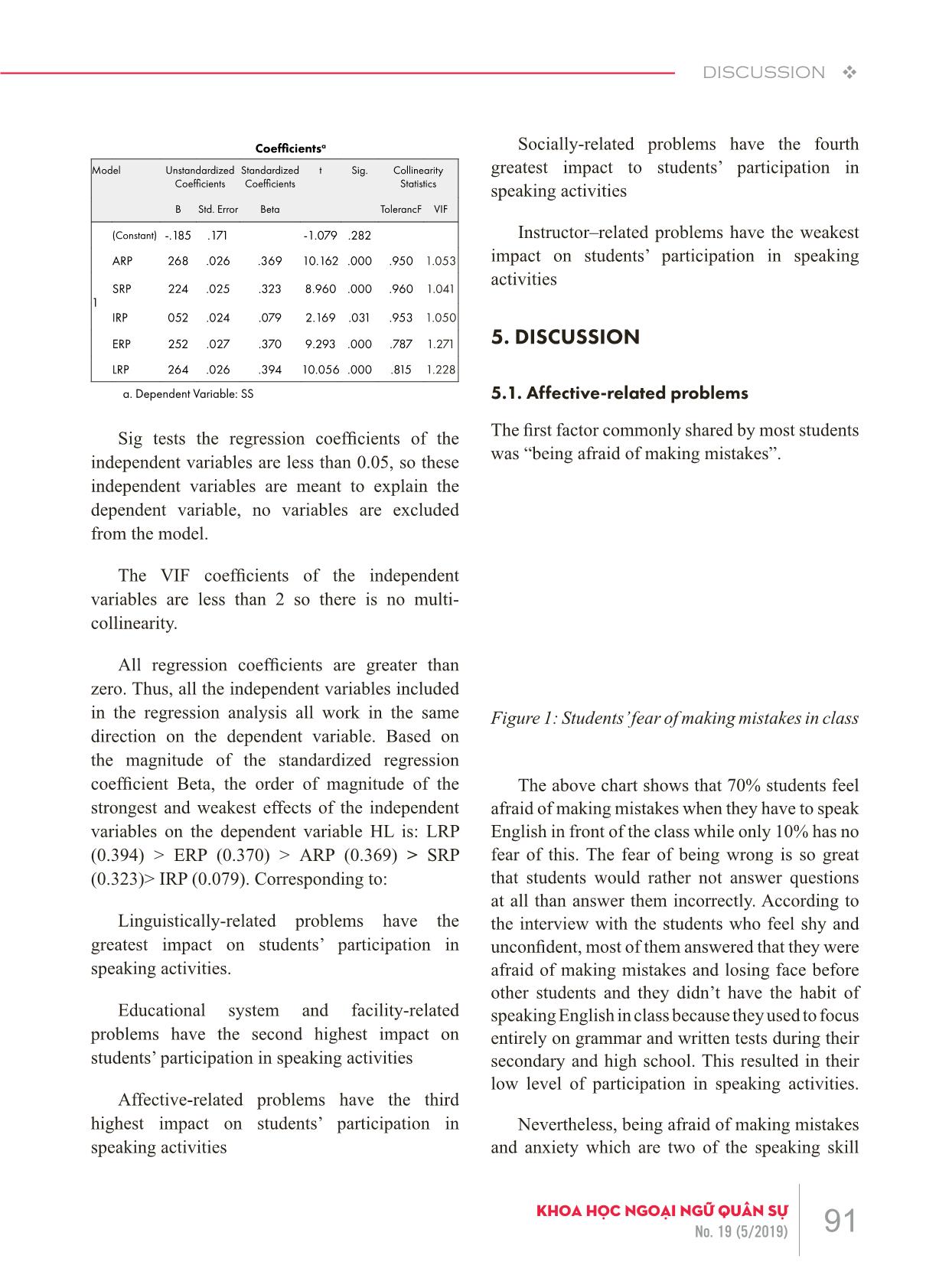
Trang 6
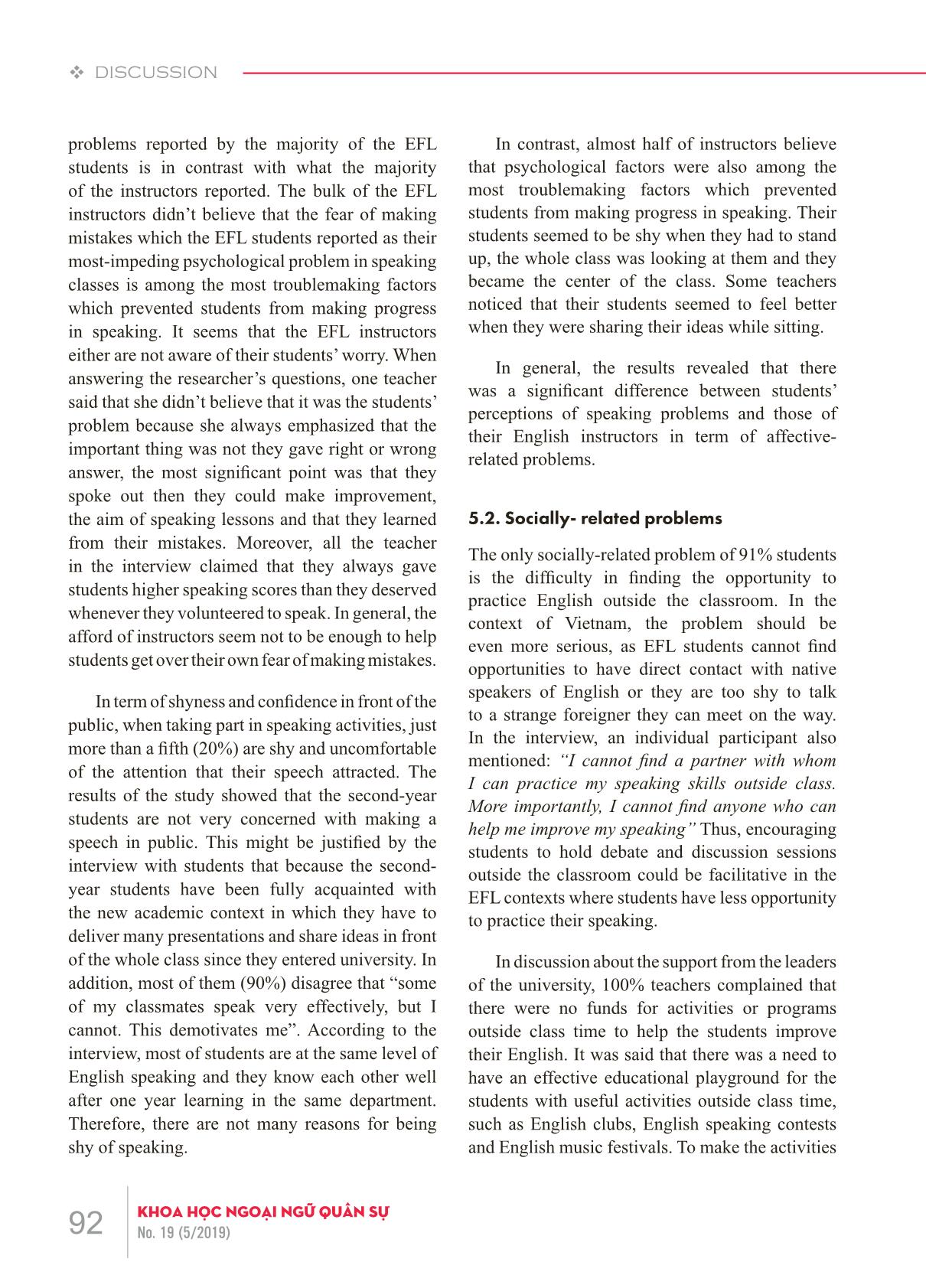
Trang 7
Tóm tắt nội dung tài liệu: An investigation into the factors that hinder the participation of the second-year English-major students in English speaking lessons at Thuong Mai University

of Linguistics and TESOL. Thuong Mai University is not the university which focuses on foreign language studies. The students’ academic results at entrance examination are pre-intermediate. The levels of English proficiency of the students of English faculty at Thuong Mai University are generally different. Most of the students come from rural areas with a little chance for speaking English. As a result, when they enter university, it is quite difficult for them to become confident in speaking English as expected. 3.2. The Syllabus and Materials for Speaking skills At Thuong Mai University, English majors have to study four skills in four years. Speaking syllabus is designed to help students develop English-speaking skill both accuracy and fluency. By the end of the course, the students would be able to communicate effectively in job-related situations and daily life, 89KHOA HỌC NGOẠI NGỮ QUÂN SỰNo. 19 (5/2019) DISCUSSION v as well as establish, and maintain relationships with members of the target community. They will be able to present their ideas about personal and social issues in English. The main topics include society, economics, education, healthy, money and technology. Teaching and learning speaking skills, a compulsory subject of that program, is integrated with that of other skills in one textbook, The Business Intermediate, which is taught in four courses in four semesters and accounts for 8 credits. It means that there is no separated speaking skill textbook or syllabus for English-majored students. The book is laid out with plenty of authentic models of spoken language, and communicative activities to help students practice using the language in the classroom. Most importantly, there are many pair- work and group-work activities in the book. The testing-assessment includes speaking assessment by class participation during the course of study and a presentation score without a final oral test. In term of methodology, teachers usually use the communicative method of teaching. Moreover, students often play the key role in the lesson, being the main speakers. Teacher only acts as an advisor during communication activities. 3.3. The objects Teachers: They are 10 Vietnamese females aged from 28 to 50. Most of them are regarded as experienced teachers with at least 7 teaching years. All of them have got Master Degree in teaching English. Thus, they can be representatives for the foreign language teaching staff in Thuong Mai University. Students: 175 second-year-students from the faculty of English in Thuong Mai University responded to the questionnaires. These students passed the National Enrollment Examination and most students took the entrance examination in English in 2017. Their levels varying from lower pre-intermediate to pre-intermediate are proven by the fact that they have studied English for at least 3 years at high school and one year in the university as well as the results of their first year in university. The average size of their class varies from 30 to 40 students. “The Business- Intermediate” is used as their textbooks. 3.4. Data collection instruments Questionnaire The factor analysis revealed included affective-related problems, socially-related, instructor- related problems, educational system and facility-related problem and linguistically- related problems. The questionnaire (both instructors’ and students’ versions) involves 35 speaking problems. All the statements of which were oriented on a Likert scale ranging from 1 (strongly disagree) to 5 (strongly agree). To ensure the validity and reliability of the questionnaire, the following steps were taken: 1. Before the study began, 20 second-year students and ten instructors sat a semi-structured interview. The questions of the semi-structured interview were utilized after they were approved by two experts in the field. The reason behind this was to make sure that all the problems which students and their English instructors might face in speaking classes were included in the questionnaire, the main items of which were to be drawn from the interviews. 2. The questionnaire hence constructed was piloted with 73 students. To further ensure the validity of the questionnaire, exploratory factor analysis was run. Since the results of the factor analyses indicated that some of the items correlated poorly with others, nine of the items with low anti- image correlation were omitted from the 41-item speaking skills problems questionnaire and three new items were added (i.e. My instructors do not 90 KHOA HỌC NGOẠI NGỮ QUÂN SỰNo. 19 (5/2019) v DISCUSSION teach us how to express appropriate speech acts; My instructors do not tell us what to do when we cannot find the correct and appropriate word, structure and sentence during our speaking; and there is no cooperation spirit among my classmates in my speaking classes) were added. Thus, the questionnaire was finally based on 35 items. Then, it was validated and factor analyzed for the second time with 175 students, and the Kaiser-Meyer-Olkin (KMO) measure of sampling adequacy and Bartlett’s Test of Sphericity were calculated, the results of which are summarized in the following table which shows an acceptable KMO index (0.58). Kaiser-Meyer-Olkin Measure of Sampling Adequacy. .580 Bartlett’s Test of Sphericity Approx. Chi-Square 218.342 Df 153 Sig. .000 3. The reliability of the questionnaire was also calculated using Cronbach’s Alpha, which shows that the questionnaire possessed an acceptable internal consistency (α = 0.72) Semi-structured interview To maximize the validity of the data, to make the findings more generalizable and to have a more in-depth analysis of the participants’ speaking skills problems, the data collection procedure was triangulated. That is, 30 students and ten instructors, selected from among the participants of the study based on stratified random sampling, also sat a semi-structured interview in addition to filling out the questionnaire. 3.5. Data analysis Quantitative analysis Descriptive statistics (means and standard deviations) was applied to address the first research questions. Then to see if there is any statistically significant influence of the five factors on speaking skill problems, a one-way ANOVA was employed. Qualitative analysis The participants’ responses to the interview questions were audio-recorded and transcribed. Then, the common patterns and recurring themes of the responses were identified, coded, using SPSS20 and were subjected to frequency analysis. Finally, both the qualitative and quantitative results of the study were analyzed and discussed. 4. FINDINGS Factors that hinder students’ participation in speaking activities - Linguistically-related problems: LRP - Educational system and facility-related problems: ERP - Affective-related problems: ARP - Socially-related problems: SRP - Instructor–related problems: IRP Model Summaryb Model R R Square Adjusted R Square Std. Error of the Estimate Durbin- Watson 1 .873a .673 .729 .20721 1.927 a. Predictors: (Constant), LRP, ARP, SRP, IRP, ERP b. Dependent Variable: SS 5 variables LRP, ARP, SRP, IRP, ERP affect 72.9% of students’ speaking ability; 27.1% due to random errors and other factors ANOVAa Model Sum of Squares df Mean Square F Sig. 1 Regression 45.319 5 9.660 43.669 .000b Residual 20.796 171 .083 Total 62.115 173 a. Dependent Variable: SS b. Predictors: (Constant), LRP, ARP, SRP, IRP, ERP Significance F is 0.00 <0.05, so the linear regression model is consistent with the data set and can be used. 91KHOA HỌC NGOẠI NGỮ QUÂN SỰNo. 19 (5/2019) DISCUSSION v Coefficientsa Model Unstandardized Coefficients Standardized Coefficients t Sig. Collinearity Statistics B Std. Error Beta TolerancF VIF 1 (Constant) -.185 .171 -1.079 .282 ARP 268 .026 .369 10.162 .000 .950 1.053 SRP 224 .025 .323 8.960 .000 .960 1.041 IRP 052 .024 .079 2.169 .031 .953 1.050 ERP 252 .027 .370 9.293 .000 .787 1.271 LRP 264 .026 .394 10.056 .000 .815 1.228 a. Dependent Variable: SS Sig tests the regression coefficients of the independent variables are less than 0.05, so these independent variables are meant to explain the dependent variable, no variables are excluded from the model. The VIF coefficients of the independent variables are less than 2 so there is no multi- collinearity. All regression coefficients are greater than zero. Thus, all the independent variables included in the regression analysis all work in the same direction on the dependent variable. Based on the magnitude of the standardized regression coefficient Beta, the order of magnitude of the strongest and weakest effects of the independent variables on the dependent variable HL is: LRP (0.394) > ERP (0.370) > ARP (0.369) > SRP (0.323)> IRP (0.079). Corresponding to: Linguistically-related problems have the greatest impact on students’ participation in speaking activities. Educational system and facility-related problems have the second highest impact on students’ participation in speaking activities Affective-related problems have the third highest impact on students’ participation in speaking activities Socially-related problems have the fourth greatest impact to students’ participation in speaking activities Instructor–related problems have the weakest impact on students’ participation in speaking activities 5. DISCUSSION 5.1. Affective-related problems The first factor commonly shared by most students was “being afraid of making mistakes”. Figure 1: Students’ fear of making mistakes in class The above chart shows that 70% students feel afraid of making mistakes when they have to speak English in front of the class while only 10% has no fear of this. The fear of being wrong is so great that students would rather not answer questions at all than answer them incorrectly. According to the interview with the students who feel shy and unconfident, most of them answered that they were afraid of making mistakes and losing face before other students and they didn’t have the habit of speaking English in class because they used to focus entirely on grammar and written tests during their secondary and high school. This resulted in their low level of participation in speaking activities. Nevertheless, being afraid of making mistakes and anxiety which are two of the speaking skill 92 KHOA HỌC NGOẠI NGỮ QUÂN SỰNo. 19 (5/2019) v DISCUSSION problems reported by the majority of the EFL students is in contrast with what the majority of the instructors reported. The bulk of the EFL instructors didn’t believe that the fear of making mistakes which the EFL students reported as their most-impeding psychological problem in speaking classes is among the most troublemaking factors which prevented students from making progress in speaking. It seems that the EFL instructors either are not aware of their students’ worry. When answering the researcher’s questions, one teacher said that she didn’t believe that it was the students’ problem because she always emphasized that the important thing was not they gave right or wrong answer, the most significant point was that they spoke out then they could make improvement, the aim of speaking lessons and that they learned from their mistakes. Moreover, all the teacher in the interview claimed that they always gave students higher speaking scores than they deserved whenever they volunteered to speak. In general, the afford of instructors seem not to be enough to help students get over their own fear of making mistakes. In term of shyness and confidence in front of the public, when taking part in speaking activities, just more than a fifth (20%) are shy and uncomfortable of the attention that their speech attracted. The results of the study showed that the second-year students are not very concerned with making a speech in public. This might be justified by the interview with students that because the second- year students have been fully acquainted with the new academic context in which they have to deliver many presentations and share ideas in front of the whole class since they entered university. In addition, most of them (90%) disagree that “some of my classmates speak very effectively, but I cannot. This demotivates me”. According to the interview, most of students are at the same level of English speaking and they know each other well after one year learning in the same department. Therefore, there are not many reasons for being shy of speaking. In contrast, almost half of instructors believe that psychological factors were also among the most troublemaking factors which prevented students from making progress in speaking. Their students seemed to be shy when they had to stand up, the whole class was looking at them and they became the center of the class. Some teachers noticed that their students seemed to feel better when they were sharing their ideas while sitting. In general, the results revealed that there was a significant difference between students’ perceptions of speaking problems and those of their English instructors in term of affective- related problems. 5.2. Socially- related problems The only socially-related problem of 91% students is the difficulty in finding the opportunity to practice English outside the classroom. In the context of Vietnam, the problem should be even more serious, as EFL students cannot find opportunities to have direct contact with native speakers of English or they are too shy to talk to a strange foreigner they can meet on the way. In the interview, an individual participant also mentioned: “I cannot find a partner with whom I can practice my speaking skills outside class. More importantly, I cannot find anyone who can help me improve my speaking” Thus, encouraging students to hold debate and discussion sessions outside the classroom could be facilitative in the EFL contexts where students have less opportunity to practice their speaking. In discussion about the support from the leaders of the university, 100% teachers complained that there were no funds for activities or programs outside class time to help the students improve their English. It was said that there was a need to have an effective educational playground for the students with useful activities outside class time, such as English clubs, English speaking contests and English music festivals. To make the activities
File đính kèm:
 an_investigation_into_the_factors_that_hinder_the_participat.pdf
an_investigation_into_the_factors_that_hinder_the_participat.pdf

